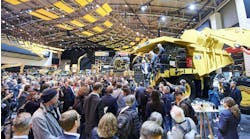Danfoss Power Solutions first announced it would acquire Eaton’s hydraulics business in 2020. The acquisition was completed in 2021, bringing together two of the industry’s largest hydraulics companies. Danfoss made the acquisition because of the growth opportunities it sees in hydraulics and the complementary nature of the two companies.
In September 2022, the first Danfoss Distributor Meeting was held since the merger. During the event company executives provided insight into how the companies have come together under a single brand, and what work yet needs to be done. They also offered a look at current market conditions and the various technological areas in which the company is investing.
READ MORE: How Company Mergers Bring Expanded Market Opportunities
Power & Motion had the opportunity to speak with Eric Alström, President of Danfoss Power Solutions, while at the distributor meeting about how things are fairing since the acquisition of Eaton as well as current company and industry trends.
Editor’s note: Questions and responses have been edited for clarity.
Power & Motion (PM): How has the merger since the acquisition of Eaton been going and what still needs to be done?
Eric Alström (EA): I'm immensely proud that [from] day one, August 2 last year (2021), we started working together without any IT glitches. We had set a target to try to have the new organization up and running January 1 (2022). And bringing two $2 billion companies together was very ambitious, but I'm really proud of the team that we actually managed [to do so]. So, January 1 all of our employees knew to whom they report, they knew the new structure, the new organization, and we actually had financial transparency as of January 1 this year. It was a really aggressive target to try to be done with all that by January 1, in just 5 months, but we did [it]. What remains to be done now is that some of the IT systems, the backbones, need to be homologated and so we're embarking on one ERP, which we already started in Danfoss. We've invested significantly in that and now we're bringing all Eaton or the whole legacy Eaton organization onto that one ERP structure. So, it's basically IT homologation that remains to be done. Other than that, we are operating as one new, cool business.
PM: What have been some of the biggest benefits you have seen from the merger so far?
EA: For Danfoss it was always a dream to have fluid conveyance. It was always a dream to be in industrial. But it's awfully hard to build that organically, the massive investments and know-how you would have to build from scratch, it becomes very difficult. And so that's of course, two major assets that we acquired. It's not just the product, it’s the people behind those assets that made a difference. But then it's also the geographical reach, and what you have witnessed here [at the distributor meeting], a fantastic distribution network. And we want to keep and nurture this distribution network, and not downsize it or anything like that. This industry is big, there is enough business for everybody out there. Those are sort of the big, tangible things that make us super excited about this. And also, maybe then if you turn it around from a customer perspective, it is this significantly larger product portfolio and that we have a better network, especially for distribution partners, but also our OEMs can benefit from a bigger product portfolio. And additional capacity available.
PM: You were saying during your presentation Danfoss is really bullish on hydraulics. Why is that and can you go into what makes hydraulics such an important industry to be in?
EA: Absolutely. If you look at the industry growth over the last 20 years, it's around 2.5-3% annually, but actually, over the last 10 years or so it's accelerated and become a little bit more. And it's driven by many different things such as ag and food production in an increasingly populated world and there's simply more to be done there. Also, in terms of thinking about how to do it [while] being more efficient and more productive, those are things that are at the top of the agenda for us. But also, construction, there is a strong trend towards urbanization, and the machines that our customers produce are used in those instances. Now, electrification is coming, you've seen it, it's coming in a big way. But there are many machines where power and energy densities simply speak in favor of hydraulics. There is no solution to batteries as an energy source, putting it on a tractor – where are you going to put it? Basically, [you] put it behind on a trailer and then drive around; that's not going to work. But that said, there's also electrohydraulic solutions. And regardless if a machine becomes electrified or not, it will still have hydraulic content because a lot of the work functions that you're doing, you can’t package electric motors, for instance. So, maybe the diesel engine goes away as a power source and you will have a battery pack and electric propulsion, maybe, but a lot of the functions in machines will remain hydraulic for the foreseeable future. It is important to recognize there is nothing harmful for the environment with hydraulics as long as we don't leak oil, which we tend not to do nowadays; it used to be a big issue in the past. It really isn't anymore. So actually, hydraulics is as green as anything else, if you look at it from that perspective, without a diesel engine.
PM: Are there areas of the hydraulics market you see as having better growth opportunities versus others?
EA: I think you will see this steady growth, just driven by economic growth, frankly. Our industry is very cyclical, also, so when there is a downturn farmers typically don't buy machinery, governments stop spending on infrastructure, and so forth. So, it will go up and down a little bit, but over the longer-term perspective—like we like to think at Danfoss a little bit more long term—we still see tremendous growth for years to come. And not just in off-highway machinery, but also hydraulics for industrial solutions.
PM: You were mentioning during your presentation about regionalizing Danfoss’ supply chain, could you go into what the company is doing and the benefits?
EA: I think it's been a challenge for everybody in most industries these past 2 years, of course amplified by the pandemic. But for a while now we have recognized that we're tying up a lot of inventory, which means a lot of cash and long supply chains, and we can put that cash to work in a better way if we pull supply chains closer. That's just the financial aspect. The other one is supply chain risk. Things happen when you ship [products] over long distances. And we've had so many instances over the past 2 years, whether it gets stuck in customs or there's a hurricane somewhere and you can’t ship out of a certain port, those things happen. So, it's just become very prudent for us to pull everything closer. We're just doing it step by step by looking at basically, which are the components that are costing us the pain, and we take them one by one, and we localize them, many times by having to invest locally, finding new suppliers locally. So, that's not done overnight. It's hard work.
PM: Are there any specific areas that have been the biggest pain points or where you’ve seen the biggest challenges regarding the supply chain?
EA: If we put semiconductors [to] the side because that's a very specific issue driven by tremendous demand in all industries, we've had other supply chain shocks in terms of container freight, where demand rose exponentially and therefore prices rose. Also, availability of containers became difficult. Electronics is not such a big issue for us, because part of our business model is to fly those components, they're small, they're not heavy. That's how we calculate the business case when it comes to electronics. But heavier stuff like end caps [and] housings, these are cast iron parts that are being hauled between regions. That's where we focus our attention now.
PM: Are you seeing any sort of reprieve to the supply chain issues? Do you anticipate any alleviation to the supply chain challenges?
EA: I think it's easing a little bit. We see that across the board. We don't have to buy semiconductors on spot buy like we did this past year, which can be extremely costly. We sometimes had to pay 50 times more than our serial production price that we normally would pay because that was the only way of keeping our customers running. So, I think that's easing up and I also think that the availability of containers seems to be easing up, not because there's less demand necessarily but I think there's simply more containers available now. Also some of the things that took a lot of time because of the pandemic where people couldn't interact is sort of behind us now. We're still careful, because COVID is still around everywhere, but ports is a good example [where] during the pandemic a lot of extra precautions were taken that actually kind of choked the material flow through the ports. And that's eased up a little bit, so in general it is better, but these times will come again, driven by the cyclicality. So, we're still going full force on regionalization and localizing our supply chain.
PM: Changing topics, I know workforce development is an industry-wide challenge. Is there anything in particular Danfoss is doing to help with that and to attract people into fluid power or into Danfoss specifically?
EA: Yeah, great question because like many people say, it's [fluid power] perhaps for engineers coming out of the universities not the first industry they think about. When we put what I call the Danfoss box on the table and open the lid, they have a chance to look inside and see we're working with really cool things like software, advanced algorithms for autonomous solutions, [and] connectivity. We supply hoses for data centers; our colleagues in climate solutions are doing the entire cooling system, reaping excess heat, and heating family homes with excess heat from the datacenter, this is just one example. And people say, ‘Wow, this is actually pretty cool.’
And the other thing which is very high on our agenda is that we aspire to be a very green company, and that resonates with Generation Z. University students coming out [of school] and younger employees, frankly, feel that is as important as having cool technologies. And so, we're really emphasizing that. We're also working together with universities where we are present. Just one example here in the U.S. is Iowa State University, which is right next door to our Ames campus. It's a great partnership over many years, where we’ve funded some of the research labs, and of course the students all hear about Danfoss and that's been great for us. But we are also doing some bold moves through what we call the Danfoss Innovation Accelerator in Cambridge, MA. So, it's basically at MIT, where we have a team and by opening the Danfoss box there we've been really, really fortunate to get a lot of great people actually joining the company there. And that's sort of the academic side of things or administrative positions. When it comes to our hourly employees, we're also doing things to make it attractive to come to Danfoss.
There's a wide range of things we're trying to do to make us attractive. In Europe, all of the offices are being converted from traditional high wall partitions to an open landscape where you don't have your dedicated desk. I don't have an office; I just go and pick a desk and sit next to any employee who happens to be in the office that day. But we're also doing other things such as having soft drinks available, water, coffee, snacks, healthy snacks that we provide for employees in those offices. And that has been a great way of bringing people in, because when they come to the interview, and they say, ‘Well, this is not a stodgy old-school hydraulics engineering company. It's a pretty progressive company.’ And we're going to embark on doing that here in the U.S. as well now.
PM: To wrap up our conversation, what technologies or trends are you most excited about either that are happening now or that you see coming in the future?
EA: That's a great question, because there's so much, so where do I start? But I think what excites me the most is that we are going to invest and keep investing in our core. And from a lot of the partners that I spoke to here [at the distributor meeting], they are super excited, because maybe the previous owner of the hydraulics business didn't see it as so strategic or didn't invest so much for the future. So now people are seeing the tremendous investments we are making in the core [business of hydraulics]. But also, many of the new things that we're doing with autonomous solutions. On-highway autonomy is a very difficult problem to solve, the liability and all those things. In our industry [mobile off-highway], we're usually in a controlled environment so it's much easier to solve those issues. I think we can do things in our industry actually a little bit quicker and be even more progressive than perhaps even on-highway automotive. That's what I mean with the Danfoss box, when we show all these cool things, people get excited. I'm pretty excited about everything we do. I mean, it sounds a little bit odd, maybe but I really am because we're not only changing Danfoss but I think we're actually changing our industry.




